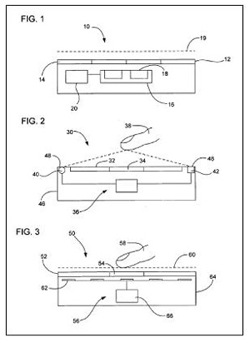Business
Say hello to HoverPod
Remember all the rumors about Apple's "true video" iPod? The one with the full-screen display and the virtual click wheel that appeared and disappeared as needed? My problem with that concept was something that has been the scourge of the iPod nano - scratches.


I originally dismissed the early "all-screen" (or button-less) iPod mockups as fantasy because of the overwhelming potential for scratching. How on earth could Apple release an iPod that required users to drag their fingers across the screen in order to change the volume or to switch tracks? It would have more scratches that a dog with fleas.
Apple appears to have learned from the scratching fiasco known as the iPod nano. On 20 July 2006, the US Patent & Trademark Office published Apple's patent application titled "Proximity detector in handheld device," (which was originally filed in September 2005.) Apple's patent details the use of proximity detection as a means for providing input to a portable electronic device.
MacsimumNews has the skinny on patent application number 20060161871:
The entire face of the device using a full screenPart two of their report contains details about proximity sensing fields, the iPod as a modem and applications as a PDA, gaming device and cell phone. The smoking gun for me is the section about Apple using proximity detection for the iPod GUI:
In one embodiment, the user interface 104 of the computing device 100 includes a full screen or near full screen display 108. A full screen display is a display that consumes, or at least dominates, a surface (e.g., front surface) of the computing device 100. In one example, a full screen display consumes substantially the entire front surface of the computing device 100 (in both directions). The full screen display may for example consume at least 90% of a front surface of a housing for the computing device. It may extend edge to edge or it may fit within a small bezel of the housing at the edge of the device. The full screen display may have a variety of different configurations depending on the overall footprint of the device. If the device is wide, the full screen display may have a traditional aspect ratio of about 4:3. If the device is elongated, the full screen display may have an aspect ratio that is more panoramic such as 16:9.
New iPod touch screen GUISo there you have it. Apple already thought this through and came up with a solution last September. It's tough to say if and when Apple will actually implement such a technology, but it stands to reason that some day you won't have to touch your iPod to change songs, you'll just hover.
Patent application FIG. 13A shows one example of a window 530A including a list of songs 532A, and FIG. 14A shows another example of a window 530B including a list of songs 532B.FIG. 13A may, for example, be a graphical user interface displayed on an iPod.RTM. manufactured by Apple Computer of Cupertino, Calif., and FIG. 14A may for example be a graphical user interface associated with a music management program, such as iTunes.RTM. manufactured by Apple Computer of Cupertino, Calif.
Can you think of a reason why this would be bad?